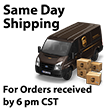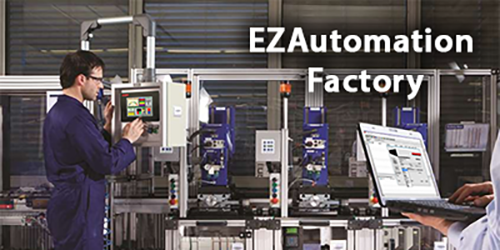Basic Sensor Sense
 by Paul Figie, Application Engineer, EZAutomation
by Paul Figie, Application Engineer, EZAutomation
At times it can be hard to make sense of all the different types of sensors.
In the Automation world there are many types of sensors and each one has its advantages in the correct application. In this article I will go through the bulk of sensor types and discuss the workings advantages & disadvantages. The goal is to save the reader time and legwork of research in basic sensor selection.
The two main categories for sensors can be defined by the output of the sensor:
- A) Discrete Output gives a single ON or OFF signal for the condition it is sensing.
- B) Numeric Output Has a variable output signal for the condition it is sensing.
This article is dealing with Discrete Output Sensors. My next Article will deal with Numeric Output Sensing.
Mechanical limit switches: Good for switching higher currents. Disadvantages are limited to their mechanical life and require physical contact to actuate. It is better to move away from the mechanical style to solid state devices. Solid State sensors are more reliable, accurate and last longer when correctly used.
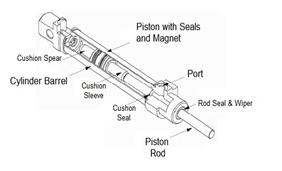 Magnetic reed switches: These are used in a variety of applications like door switches and float switches and just about anything you can put a magnet on. Many manufacturers offer magnets in their hydraulic & pneumatic cylinders. By installing a magnet on the piston of their cylinders switches can be mounted on the outside and sense the stroke. The solid state version of this uses a hall-effect semiconductor enabling longer cycle life and even tighter sensing windows can be achieved. Now GMR (Giant Magneto Resistive) technology has even improved solid state magnetic sensing to yet a higher level. The advantage to using this method is the sensors are not as exposed and can give a more compact cleaner looking. Disadvantages to these types of sensors are that the magnets inside the cylinder are not visible making them more difficult to adjust and trouble shoot. Don’t forget to use flow control and cushioning in the cylinder actuation or shock can crack the magnets.
Magnetic reed switches: These are used in a variety of applications like door switches and float switches and just about anything you can put a magnet on. Many manufacturers offer magnets in their hydraulic & pneumatic cylinders. By installing a magnet on the piston of their cylinders switches can be mounted on the outside and sense the stroke. The solid state version of this uses a hall-effect semiconductor enabling longer cycle life and even tighter sensing windows can be achieved. Now GMR (Giant Magneto Resistive) technology has even improved solid state magnetic sensing to yet a higher level. The advantage to using this method is the sensors are not as exposed and can give a more compact cleaner looking. Disadvantages to these types of sensors are that the magnets inside the cylinder are not visible making them more difficult to adjust and trouble shoot. Don’t forget to use flow control and cushioning in the cylinder actuation or shock can crack the magnets.
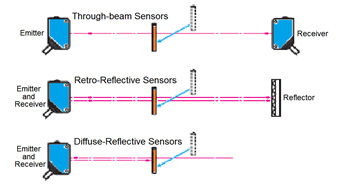 Photo optical sensors: There are 3 types. (a) Through Beam Sensors, (b) Retro-Reflective Sensors and (c) Diffuse-Reflective Sensors. Through beam has two parts; an optical transmitter and an optical receiver. Reflective or “Retro-Reflective” that send a beam to a target that reflects back making the send/receive in the same device. As the beam is broken by the object being sensed a signal is outputted. Diffuse-Reflective type opposite of the retro-reflective it uses the light reflected off the object being detected to give a signal back. The diffused type doesn’t have the long range like the through beam or retro-reflective and is more dependent on the size, texture, and shape of the object to be detected. The advantages to photo sensors is they can cover extremely large distances. The through beam has the longest range and is the most reliable but requires 2 devices to be wired adding wiring cost. The disadvantages to Photo optical sensors are that in dusty and dirty environments they can get buildup on lenses and have to be cleaned. Alignment of the sensors and reflectors are critical and could be another disadvantage if they get bumped and misaligned. A third type of Photo optical is the Most Photo Optical sensors send a signal contained in the beam giving them the ability to distinguish between its light source and other unwanted signals. Ranges can extend to greater than 30 feet.
Photo optical sensors: There are 3 types. (a) Through Beam Sensors, (b) Retro-Reflective Sensors and (c) Diffuse-Reflective Sensors. Through beam has two parts; an optical transmitter and an optical receiver. Reflective or “Retro-Reflective” that send a beam to a target that reflects back making the send/receive in the same device. As the beam is broken by the object being sensed a signal is outputted. Diffuse-Reflective type opposite of the retro-reflective it uses the light reflected off the object being detected to give a signal back. The diffused type doesn’t have the long range like the through beam or retro-reflective and is more dependent on the size, texture, and shape of the object to be detected. The advantages to photo sensors is they can cover extremely large distances. The through beam has the longest range and is the most reliable but requires 2 devices to be wired adding wiring cost. The disadvantages to Photo optical sensors are that in dusty and dirty environments they can get buildup on lenses and have to be cleaned. Alignment of the sensors and reflectors are critical and could be another disadvantage if they get bumped and misaligned. A third type of Photo optical is the Most Photo Optical sensors send a signal contained in the beam giving them the ability to distinguish between its light source and other unwanted signals. Ranges can extend to greater than 30 feet.
Single point optical sensors: These have a cone shape that gives an output when it comes in contact with a liquid. It works like the old battery water level eye with optics to give an output. These sensors are Diffuse-Reflective type and are designed specifically for free flowing clean liquids. A disadvantage of this sensor is residue on the “eye” which can cause a false reading.
Ultrasonic Proximity sensors: Comes in the same varity as the photo optical but use ultrasonic sound waves instead of light. The internal workings of Ultrasonic proximity sensors are more complex than photo optical proximity sensors which raises the cost. The sensing range of an ultrasonic is not as good as photo optic and is slower in response time. The advantage to ultrasonic is the soundwaves will bounce off from clear objects that light would go through.
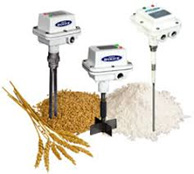 Vibrating or tuning fork: Level sensors are good for detecting powders, bulk solids, grains, slurries and liquids. These sensors have a vibrating element extending into the vessel that comes in contact with the material being sensed. The vibration is altered when the material is present and an output is indicated. The vibration will clear the sensor when the material to be sensed is no longer present. In general this type of sensor it is very reliable. Disadvantages are they are more expensive and are larger in size.
Vibrating or tuning fork: Level sensors are good for detecting powders, bulk solids, grains, slurries and liquids. These sensors have a vibrating element extending into the vessel that comes in contact with the material being sensed. The vibration is altered when the material is present and an output is indicated. The vibration will clear the sensor when the material to be sensed is no longer present. In general this type of sensor it is very reliable. Disadvantages are they are more expensive and are larger in size.
Capacitive Proximity sensor: This type of sensor will detect a wide variety of materials Including wood, plastics, liquids and metals. Although materials that are electrical conductors will be detected easier they do not have to be conductors. Capacitive proximity sensors have the ability to detect materials that can be electrically charged. They usually have a gain adjustment on them and have to be set for the material being detected. Disadvantage is they are more susceptible to temperature and humidity changes and have to be adjusted. The response time is slower than Inductive Proximity sensors.
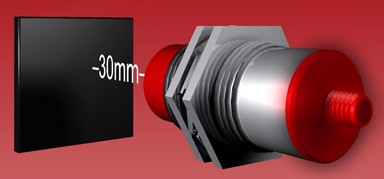 Inductive Proximity sensor: This type of sensor is the most commonly used proximity sensor in industrial automation. It detects most metals and senses the ferrous metals (Iron & Steel) best. They come in a wide variety of sizes, styles and sensing distance.
Inductive Proximity sensor: This type of sensor is the most commonly used proximity sensor in industrial automation. It detects most metals and senses the ferrous metals (Iron & Steel) best. They come in a wide variety of sizes, styles and sensing distance.
EZAutomation has a 30mm Proximity sensor that will sense a metal object up to 30 mm (over 1 inch).
With any project requiring sensors it is always a good idea to test the actual items in the application environment they will be used in when possible. This information should help you in getting started with the best type for your application.


